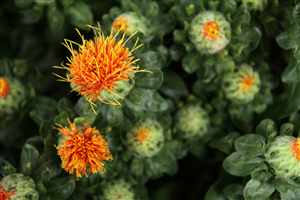Safflower (Carthamus tinctorius)
Main Facts about Safflower

Using Safflower
Safflower is extremely effective in lowering cholesterol levels. Safflower oil might also be able to help lower blood sugar, and it’s also been studied for its antioxidant qualities. Safflower oil even has some cosmetic uses, such as a moisturizer for very dry skin enabling the skin to gain a healthy glow. It reduces the appearance of wrinkles. Topically applied, the soothing and antioxidant properties of safflower oil help to treat damage and inflammation. Used for all kinds of skin disorders. Helps skin heal open wounds and bruises. Laxative effect helps bowel movements. Encourages menstruation and treats abdominal pains. Safflower yellow has analgesic, sedative, and anticonvulsant effect on the central nervous system. In addition, it has immunosuppressive effect too. Safflower seeds can be used in bird feeders instead of sunflower seeds because squirrels don’t like them. Safflower oil is also used as a medium for oil paints.Safflower is a remedy for: Anxiety, Constipation
Cooking with Safflower
Safflower seed oil is flavorless and colorless, and nutritionally similar to sunflower oil. It is used as a cooking oil, in salad dressing, and for the production of margarine. Dried flowers are used as a less expensive substitute for saffron and were sometimes referred to as "bastard saffron".How to grow Safflower
Safflower does best in areas with warm temperatures and sunny, dry conditions during the flowering and seed-filling periods. Its production is not recommended for areas with more than 15 in. of annual precipitation or growing seasons with fewer than 120 frost-free days. Safflower is very sensitive to frost injury after stem elongation.| Rutabaga |
Sage
|